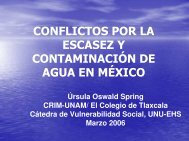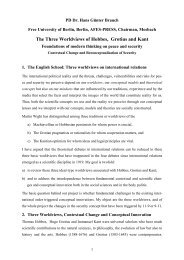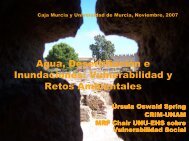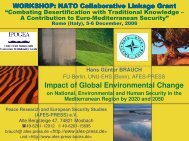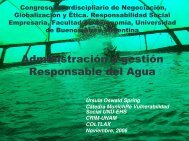Vulnerabilities
Vulnerabilities
Vulnerabilities
- No tags were found...
Create successful ePaper yourself
Turn your PDF publications into a flip-book with our unique Google optimized e-Paper software.
Gender Vulnerability, RiskPrevention and ResilienceBuildingÚrsula Oswald SpringUNU-EHS, MunichRe ChairCRIM/UNAM, Mexico
Contents 1. Basic Concepts and Focus ofthe Talk 2. Gender Security 3. Threats, Challenges,<strong>Vulnerabilities</strong>, Risks andResilience 4. Vulnerability and Gender 5. Gender Sensitive RiskManagement 6. Vulnerability and Regions 7. Needed Adaptation andMitigation Measures:Combating <strong>Vulnerabilities</strong>,Threats & Avoiding Violence: ALong-term Task with GenderSensibility
1.1 Focus of the Talk and MainQuestions Why are women and other socialvulnerable groups so highly exposed tonatural risks and hazards? What are the possible policies andmeasures to improve resilience forthese social groups and to reduce theirrisks?
2. Basic Concepts and Focus ofthe Talk: Gender Security, Identity,Capacity Building and Resilience
2.2. Human, Gender and Environmental Security (HUGE)Level ofexpansionDeterminationWhichsecurity?Mode of expansionReference objectSecurity ofwhom?Value at riskSecurity of what?Source(s) of threatSecurity fromwhom or what?WithoutexpansionNational security(political, militarydimension)The StateSovereignty, territorialintegrityOther States, terrorism,sub-state actors, guerrillaIncreasedSocietal securityNations, socialgroupsNational Unity, nationalidentity(States), Nations,Migrants, Alien culturesRadicalHuman securityIndividuals(Humankind)Survival, quality of life,cultural integrityThe State, globalization,nature, GEC, poverty,fundamentalismUltra-radicalEnvironmentalSecurityEcosystem,urban andagriculturalsystemSustainabilityNature HumankindTrans-radicalGender securityGender relations,indigenous,minoritiesEquity, identity, socialrelationsPatriarchy, totalitarianinstitutions (élites,governments, religions,culture), intoleranceSource: Bjørn Møller, 2003:279 and Úrsula Oswald, 2001, 2004
2. 3.Inequality for WomenWomen in the World50.3%67% 68% 36% 41% 70%12%113%IlliterateAdults1 billionWithout Accessto Basic School300 millionWith Accessto SecundarySchool% of Womeninfected byHVI/AIDS ofall InfectedExtremePovertyRepresentationinParlamentCharge of Daily Workfor Women inDevelopingCountries(% of Work of Men)Source: UNIFEM, 2000 and UNAIDS, 200090% of all Maternal Deads ocurs in Developing Countries: (500,000 deads/year)
2. 4. Main Attributes of Social Identity Thousands of years of experience have created asociety in a specific socio-historic environmentwhere symbolic elements have developed –class,ethnicity, age, religion, race, nationality,professional attribution, political ideology,education, etc. However, they are permanentlychanging, but its main attributes –gender, sexand race- and the socioeconomic conditions –rich,poor- are stable (Habermas). Each process ofclassification implies relations of identity;inclusion or rejection and exclusion, whatconstitutes the basis of any power exercise.
2.5. Social Representations2.5. Social Representations “Systems of values, ideas and practices”simultaneously creating a system of order, are ableto offer a person the possibility to get familiar withthe social and material world. The communicationwithin a community offers a code of common socialinterchange, where several aspects of life, personaland collective history are classified withoutambiguity (Moscovici, 1976: xiii). Therefore, social representations originate in dailylife, where society is the thinking and acting system. The theory of social identity establishes a continuumbetween personal and social identity with aprocessual, relational, multidimensional, contextualand essentialist character.
2.6. Social Identity Tajfel (1979:31) affirms that social identity is generatedin a world where processes of unification anddiversification are occurring with giant steps, faster thanever in history. Hogg and Abrams (1988: 78) argue that persons have abasic necessity to simplify and order reality, where thecategorization of the social environment is elaboratedby social comparison, basically to improve self-esteem. Social representation of gender is specifically chargedwith stereotypes, to be weak, incapable, dependent andvulnerable. These are social categories that are rich andcomplex in a symbolic system that has been sociallyand dialogically constructed (Habermas, 1998, 2000,2001). Both are part of an inalienable collective life,enriched by ideologies, rites, beliefs and daily practices.
2.7. Characteristics of Social IdentitySocial identity is: processual resulting from and leading to permanentchange; relational due to its transformation linked tointeraction; multidimensional operating inside, betweenindividuals, groups and ideologies (Doise, 1986); contextual forging relationships in specific contexts; essential due to the diversity and complexity ofsocial interactions that are sustained andtransformed by identity processes (Serrano, 2004,2005).
3. Threats, Challenges, <strong>Vulnerabilities</strong>,Risks and Resilience
3.1. Vulnerability Results from “poverty, exclusion, marginalization andinequities in material consumption” O’Riordan (2002: 369). “The conditions determined by physical, social, economic,and environmental factors or processes, which increase thesusceptibility o a community to the impact of hazards”(ISDR, 2004: 7) “Is conceptually located at the interaction of nature andculture” that also links “social and economic structures,cultural norms and values and environmental hazards”(Oliver-Smith, 2004:11). Increases the empowerment of victims. Wisner (2004: 194-205) distinguishes four approaches for dealing with socialvulnerability: demographic, taxonomic, situational,contextual or proactive.
3. 2. Challenges,Capacity andResilence Challenges are a combination of potential and real institutional,societal, economic and political processes, that are able to dealwith risks, fears and hazards. Capacity is “a combination of all the strengths and resourcesavailable within a community, society or organization that canreduce the level or risk, or the effects of a disaster.” (ISDR, 2004:2) Resilience is “the capacity of a system, community or societypotentially exposed to hazards to adapt, by resisting or changingin order to reach and maintain an acceptable level of functioningand structure. This is determined by the degree to which thesocial system is capable of organizing itself to increase itscapacity for learning from past disasters for better futures,protection and to improve risk reduction measures.” (ISDR,2004: 6)
3.3. Risks Risk= Hazards x <strong>Vulnerabilities</strong> (sometimes mulitiplied byExposure to a physical threat, Segob, Mexico); H and V areestimated probabilistically; E in money. “The probability of harmful consequences or expectedlosses –deaths, injuries, property, livelihoods, economicactivities, resulting from interaction between natural orhuman-induced hazards and vulnerable conditions” (ISDR,2004: 6). Social contexts can change the perception of risks and theirunderlying causes.
4. Vulnerability andGender
4.1. Elements of VulnerabilityAssessmentVulnerability assessment requires collecting andanalyzing data linked to building consciousness on: Types of hazards and frequency Elements at risk and how to reduce them Socioeconomic conditions and types of shelter Gender and family structure Genuine coping strategies Mapping specific hazard prone locations Learning from previous disasters and coping strategies Training for evacuation Resettlement of people at risk Evaluation of training and hazard mitigation process
4.2. Women and Disasters ManagementWater and food production in hand of women: Under normal conditions women produce half of world food; indeveloping countries even 60% to 80%; But women in México only own 17% of their land and in Africa 2 %; Women practice survival strategies in coping with long-term disasterssuch as economic crises and famine. They contribute in Africa to:– 33% of the paid labor force– 70% of agricultural labor days– 60-80% of subsistence production– 100% of food transformation– 80% of food storing– 90% of spinning and weaving– 60% of harvesting and market activities– 2% own land or have land rights (FAO, 2002)
5. Gender Sensitive Risks,<strong>Vulnerabilities</strong>and their Management
5.1. Gender, Threats and DisastersWomen contribute subjective and objective valuesSubjective values (social identity): Caring about their families, children, neighbors and those in need Positive self-esteem in crisis situations Emotionally stabilizing families before, during and after a disaster Guardians of traditions and values Locally attachedObjective values (social representation): Flexible, adaptable and able to shift activities immediately bydiversifying (refugee camps, survival activities, collection,reconstruction, services, agriculture, reforestation, ecotourism,) Open to collaborate in rescue activities Generate survival strategies in case of disasters Contribute to the national economy Create local employments, incomes and stabilize emigration Generate political stability and conciliate conflicts
5.2. Gender Aspects in Sri Lanka’s Tsunami5.2.Gender (%) Marital status (%)Female 65.3 NM CT WNAAge (%)1-4 13.95-9 11.156-70 9.771> 15.3TTActivity (%)Student 27.4HUEUNATEducational status (%)OLALHNATSource: Siri Hettige – University of Colombo & UNU-EHSSarath Amarasinghe – University of RuhunaNishara Fernando – University of Colombo
5.3. Activity : Gender Sensitive(Unemployed & Poor): %B ASHWUnemployed 14.0 21.4Employed 37.327.5UON/A 7.9 7.6TIncome (%)B A1-4999 43.5 50.8Source: Siri Hettige – University of Colombo and UNU-EHSSarath Amarasinghe – University of RuhunaNishara Fernando – University of ColomboNAT
6. Regional Vulnerability
6.1. CaseStudy on SriLankaSource: Siri Hettige – University of Colombo & UNU-EHSSarath Amarasinghe – University of RuhunaNishara Fernando – University of Colombo
6.2. Variability of Wave Attack(snapshots from a computer simulation)red = raised sea levelblue = lowered sea levelby courtesy of DHI Water & Environment
6. 3. Regional Vulnerability in DisastersSource: Siri Hettige – University of Colombo and UNU-EHSSarath Amarasinghe – University of RuhunaNishara Fernando – University of Colombo
6.4. Environmental and Social Lost in BatticaloaNavalady – eroded foundationKalmunai – decimated settlementSource: Siri Hettige – University of Colombo & UNU-EHSSarath Amarasinghe – University of RuhunaNishara Fernando – University of ColomboMangroves damaged, WarBreached sand dunes
7. Needed Adaptation and MitigationMeasures: Combating <strong>Vulnerabilities</strong>,Threats & Avoiding Violence: ALong-term Task with Gender SensibilitySource: Siri Hettige – University of Colombo & UNU-EHSSarath Amarasinghe – University of RuhunaNishara Fernando – University of Colombo
7.1. Empirical Data with Household Characteristics ofLocal PopulationSource: Siri Hettige – University of ColomboSarath Amarasinghe – University of RuhunaNishara Fernando – University of Colombo
100 meters7. 2. Do you agree to move to a safer place vacating the presentcoastal residence by “risk zone” (Gale District, Sri Lanka)OwnedEncroachedRent/LeaseJoint ownershipRelativesOfficialhouseTotalYes268431745334078.8%12.6%5.0%1.2%1.5%.9%10066.5%75.4%85.0%50.0%100.0%75.0%68.4No1351434115786.0%8.9%1.9%2.5%.6%10033.5%24.6%15.0%50.0%25.0%31.6Total572085449781.1%11.5%4.0%1.6%1.0%.8%100Source: Siri Hettige – University of Colombo and UNU-EHS, 2005Sarath Amarasinghe – University of RuhunaNishara Fernando – University of Colombo
7.3. UNU-EHS Working Areas:7.3. UNU-EHS Working Areas:Human and Environmental SecuritysocialeconomicvulnerabilityvulnerabilityindividualvulnerabilityinfrastructurevulnerabilityUNU-EHSinstitutionalvulnerability…gendervulnerabilityplatform forvulnerability researchclimatechangehazardsenvironmentaldegradation
ACTUATION SYSTEMCORRECTIVE ANDPROSPECTIVEINTERVENTION Risk Identification Risk Reduction Disaster Management Risk Transfer Risk Gender BiasγD 1γD 2...γDnγF 1γF 2...γFnγR 1γR 2...γRn7.4. HAZARDS0.30.20.100 5 10 15 20 25 30 35 40Camas en hospitales P[0 30]Hi (I (t) ,t) i = 1, 2,…, 2mHi (I (t) ,t) i =EXPOSED ELEMENTS(COMPLEX DYNAMIC SYSTEM)VULNERABILITY FACTORS V (γD(i (t),γF i (t), γR i (t), t) i=1,2,…, , nγD i10.90.8Exposure and0.70.6Physical0.5Susceptibility0.40.3hazard dependent0.20.10Gender coping0 5 10 15 20 25 30H Área destruida P[0 20] (% a destruida / a construida) i trainingγF i10.90.8Social and0.70.6Economic0.5Fragilities0.40.30.2non hazard dependent0.100 0.1 0.2 0.3 0.4 0.5 0.6 0.7 0.8 0.9 1 Gender SpecificÁrea de barrios marginales / Área localidad P[0.05 0.75] F i ManagementγR 1i0.90.8Lack of Resilience0.70.6or Ability to Cope0.50.4and RecoveringR inon hazard dependentGender SpecificEducationPhysical DamageD ϕ(γD i)first order impactImpact FactorI (γF f i, γR i)second order impactRISKR (D(ϕ, I ) fSource: Cardona, 2005CONTROL SYSTEMRISK MANAGEMENT SYSTEM
7.5. Resettlement andCulture of Prevention andCoping Capacity withGender SensitivitySource: Siri Hettige – University of Colombo and UNU-EhSSarath Amarasinghe – University of RuhunaNishara Fernando – University of Colombo
8. Conclusions All existing statistics on disasters of the World Bank, UNsystem, Red Cross, MunichRe, except some anthropologicallocal studies do not distinguish between different grades ofvulnerability within regions, social groups and gender. Women, children, elders and other social vulnerable groupsare highly exposed to natural risks and hazards due totheir cultural accepted social identity and socialrepresentation, developed within their cultural systems. The possible policies and measures to improve resilience forthese social groups and to reduce their risks are:- compiling gender sensitive statistics;- training specifically and gender sensitively people fordisasters and risk reduction;- using the gender potential represented in subjective andobjective values to improve human and environmentalsecurity.
you for your atention


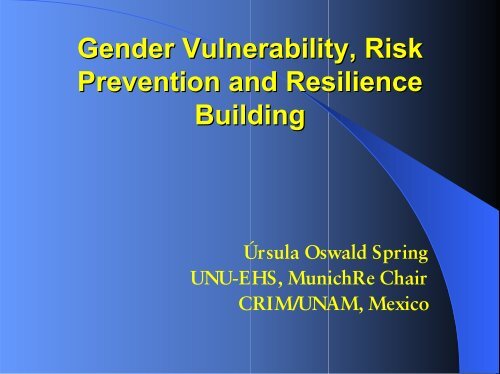
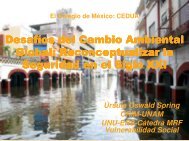
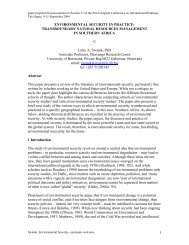
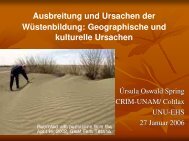
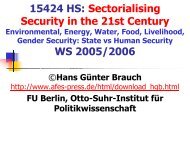

![Environmental security debates in Central Asia [and in Iran]: The ...](https://img.yumpu.com/48908494/1/184x260/environmental-security-debates-in-central-asia-and-in-iran-the-.jpg?quality=85)
